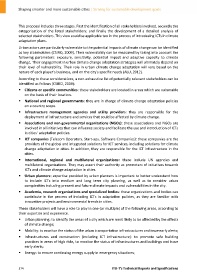Page 584 - Shaping smarter and more sustainable cities - Striving for sustainable development goals
P. 584
This proposal includes three stages. First the identification of all stakeholders involved, secondly the
categorization of the listed stakeholders; and finally the development of a detailed analysis of
selected stakeholders. This view could be applicable too in the process of introducing ICTs in climate
adaptation plans.
Urban actors are particularly vulnerable to the potential impacts of climate change can be identified
as key stakeholders (CSIRO, 2009). Their vulnerability can be measured by taking into account the
following parameters: exposure, sensitivity, potential impact and adaptive capacity to climate
change. Their engagement in urban climate change adaptation strategies will ultimately depend on
their level of vulnerability. Their role in urban climate change adaptation will vary based on the
nature of each player's business, and on the city's specific needs (ALU, 2012).
According to these considerations, a non‐exhaustive list of potentially relevant stakeholders can be
identified as follows (CSIRO, 2009):
Citizens or specific communities: these stakeholders are located in areas which are vulnerable
on the basis of their location.
National and regional governments: they are in charge of climate change adaptation policies
on a country scope.
Infrastructure management agencies and utility providers: they are responsible for the
deployment of infrastructure and services that could be affected by climate change.
Associations and non‐governmental organizations (NGOs): these associations and NGOs are
involved in all initiatives that can influence society and facilitate the use and introduction of ICTs
in cities‘ adaptation policies.
ICT companies (Telecom Operators, Start‐ups, Software Companies): these companies are the
providers of the global and integrated solutions for ICT services, including solutions for climate
change adaptation in cities. In addition, they are responsible for the ICT infrastructure in the
cities.
International, regional and multilateral organizations: these include UN agencies and
multilateral organizations. They may assert their authority as promoters of initiatives towards
ICTs and climate change adaptation in cities.
Urban planners: expertise provided by urban planners is important to better understand how
to include ICTs into medium and long term city planning, as well as to consider urban
complexities including present and future climate impacts and vulnerabilities in the city.
Academia, research organizations and specialized bodies: these organizations and bodies can
contribute in the process of including ICTs in adaptation policies, as they are familiar with
innovative projects and environmental trends in cities.
These stakeholders will have a role to play in one (or multiple) of the following areas, according to
their expertise and experience.
Urban planning: to identify the areas of a city which are most likely to be affected by the effects
of climate change;
Mobility: to monitor the status of the urban transportation infrastructures and issue early alerts;
Infrastructures and construction (including ICT infrastructure): to promote safe building
practices in areas of high risks, to monitor the status of infrastructures and buildings and issue
early alerts;
Energy: to ensure continuing energy supply in emergency situations;
574 ITU‐T's Technical Reports and Specifications

